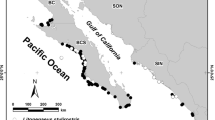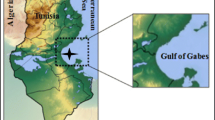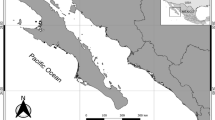Abstract
Background, aim, and scope
At tropical latitudes, and especially on the semi-arid coasts of the Brazilian Northeast, the rainfall regime governs the water quality of estuaries due to the pronounced difference between the rainy and dry seasons. These changes may be responsible for seasonal changes in bioavailability of mercury (Hg) and other pollutants to the estuarine and coastal biota. Mercury bioaccumulates along estuarine–marine food chains usually result in higher concentrations in tissues of top predators and posing a risk to both marine mammals and humans alike. The Goiana River Estuary (7.5° S) is a typical estuary of the semi-arid tropical regions and supports traditional communities with fisheries (mollusks, fish, and crustacean). It is also responsible for an important part of the biological production of the adjacent coastal waters.
Materials and methods
Trichiurus lepturus (Actinopterygii: Perciformes) is a pscivorous marine straggler. Fish from this species (n = 104) were captured in a trapping barrier used by the local traditional population and using an otter trawl net along the main channel of the low estuary during two dry seasons (D1 = November, December 2005, January 2006; D2 = November, December 2006, January 2007) and the end of a rainy season (R = August, September, October 2006). Fish muscle samples were preserved cold and then freeze-dried prior to analysis of its total mercury (Hg-T) contents. Total mercury was determined by cold vapor atomic absorption spectrometry (CV-AAS) with sodium borohydride as a reducing agent.
Results
The studied individuals (n = 104) were sub-adult (30–70 cm, 71 ind.) and adult fish (>70 cm, 33 ind.). Weight (W) (204.1 ± 97.9 g, total biomass = 21,229.7 g) and total length (TL) (63.1 ± 10.1 cm, range 29.5–89.0 cm) presented a significant (p < 0.05) correlation. Two-way ANOVA (n = 81) showed that TL and W had significant differences (p < 0.05) among seasons, being higher in D1 than in D2 and R, respectively. Moreover, season vs. month interaction were detected for the variables length and weight. For the variable weight was detected significant difference for the factor month (p < 0.05). It suggests that the fish enter the estuary at the end of the rainy season and increase in length and weight during the time they spend in the estuary. Fish from this estuary are shown to be fit for human consumption (125.3 ± 61.9 μgHg-T kg–1 w.wt.; n = 104). Fish mercury contents increased with size and weight. Correlations between TL and Hg-T (r = 0.37286) and between W and Hg-T (r = 0.38212) were significant (p < 0.05). Dryer months showed higher mercury concentrations in fish (D1 773.4 ± 207.5 μgHg-T kg–1 d.wt., n = 27; D2 370.1 ± 78.8 μgHg-T kg–1 d.wt., n = 27; R 331.2 ± 138.5 μgHg-T kg–1 d.wt., n = 27). The variable mercury concentration showed differences in relation to the factor season (p < 0.05), where fish captured during the first dry season showed the highest concentration of mercury. The correlation between Hg-T and rainfall (Rf) showed a negative correlation (r = –0.56; p < 0.05).
Discussion
The main likely source of mercury to this estuary is diffuse continental run off, including urban and industrial effluents. Since concentration of mercury in fish tissue is negatively correlated to rainfall, but positively correlated with fish length and weight, it suggests that fish growth in this estuary results in mercury uptake and concentration on the fish tissue. In the dry season of 2005–2006, when rainfall remained below the historic average, fish bioaccumulated significantly more mercury than in the dry season 2006–2007, when rainfall was within the predictable historic average. It is suggested that less rainfall, and consequently less particulate matter and less primary production in the estuary, make mercury more available to the higher levels of the estuarine food chain. In the case of higher rainfall, when river flow increases and water quality in the estuary is reduced, mercury probably is quickly exported associated to the particulate matter to the adjacent coastal waters where it then disperses. This species is a potential routine bioindicator for mercury contamination of the biota, but so far was used only with a limited number of individuals and contexts.
Conclusions
Fish from the Goiana River estuary can still be safely consumed by the local population. However, any further contamination of this resource might lead to total mercury levels above the recommended limits for pregnant women and small children. The proposed heavy dependency of total mercury levels in fish on water quality indicates that land use and water quality standards must be more closely watched in order to guarantee that best possible practices are in place to prevent bioaccumulation of mercury and its transfer along the food chain. Human interventions and climatic events which affect river water flow are also playing a role in the mercury cycle at tropical semi-arid estuaries.
Recommendations and perspectives
T. lepturus is largely consumed by coastal populations of tropical and sub-tropical countries all over the world. It is also consumed by a number of marine mammals over which we have a strong conservation interest. This species is also a link among different ecosystems along the estuarine ecocline. Therefore, knowledge of its degree of contamination might contribute to public health issues as well as marine conservation actions. Studies on mercury and other contaminants using this species as bioindicator (cosmopolitan, readily available) could help elucidating mechanisms through which pollutants are being transferred not only through the food chain, but also from estuarine–coastal–open waters. In addition, using the same species in marine pollution studies, especially as part of a mosaic of species, allows for wide range comparisons of marine food chain contamination.




Similar content being viewed by others
References
Adams DH, Onorato GV (2005) Mercury concentrations in red drum, Sciaenops ocellatus, from estuarine and offshore waters of Florida. Mar Pollut Bull 50:291–300
Barletta M, Amaral CS, Correa MFMC, Guebert F, Dantas DV, Lorenzi L, Saint-Paul U (2008) Factors affecting seasonal variations in demersal fish assemblages at an ecocline in a tropical-subtropical estuary. J Fish Biol 73:1–23
Barletta M, Barletta-Bergan A (2009) Endogenous activity rhythms of larval fish assemblages in a mangrove-fringed estuary in North Brazil. Open Fish Sci J. 2:pg–pg
Barletta M, Barletta-Bergan A, Saint-Paul U, Hubold G (2005) The role of salinity in structuring the fishing assemblages in a tropical estuary (Caeté River–East Amazon–Brazil). J Fish Biol 66:45–72
Barletta M, Costa MF (2009) Living and non-living resources exploitation in a tropical semi-arid estuary. J Coast Res SI 56 (Proceedings of the 10th International Coastal Symposium, Lisbon, Portugal)
Bittar VT, Castello BFL, Di Beneditto APM (2008) Hábito alimentar do peixe-espada adulto, Trichiurus lepturus, na costa norte do Rio de Janeiro, sudeste do Brasil. Biotemas 21(2):83–90
Cronin M, Davies IM, Newton A, Pirie JM, Topping G, Swan S (1998) Trace metal concentrations in deep-sea fish from the North Atlantic. Mar Environ Res 45:225–238
Di Beneditto APM, Siciliano S (2007) Stomach contents of the marine tucuxi dolphin (Sotalia guianensis) from Rio de Janeiro, south-eastern Brazil. J Mar Biol Assoc UK 87:253–254
Elliot M, Whitfield AK, Potter IC, Blaber SJM, Cyrus DP, Nordlie FG, Harrison TD (2007) The guild approach to categorizing estuarine fish assemblages: a global review. Fish Fish 8:241–268
Francesconi K, Lenanton RCJ (1992) Mercury contamination in a semi-enclosed marine embayment: organic and inorganic mercury content of biota, and factors influencing mercury levels in fish. Mar Environ Res 33:189–212
Froese, R and Pauly, D. (Eds) 2009 Fishbase. World Wide Web electronic publication. http://www.fishbase.org, version (08/2007)
Garcia-Rodriguez FJ, Aurioles-Gamboa D (2004) Spatial and temporal variation in the diet of the California sea lion (Zalophus californianus) in the Gulf of California, México. Fish Bull 102(1–4):47–67
Huchabee JW, Elwood JW, Hildebrand SC (1979) Accumulation of mercury in freshwater biota. In: Nriagu JO (ed) The biogeochemistry of mercury in the environment. Elsevier, Amsterdam, pp 277–302
Kasper D, Botaro D, Palermo EFA, Malm O (2007) Mercúrio em peixes—fontes e contaminação. Oecologia Brasiliensis 11:228–239
Kehrig HA, Brito JR JL, Malm O, Moreira I (2004) Methyl and total mercury in the food chain of a tropical estuary-Brazil. RMZ– Mat Geoenv 51:1099–1102
Kehrig HA, Costa M, Malm O, Moreira I (2002) Total and methylmercury in a Brazilian estuary, Rio de Janeiro. Mar Pollut Bull 44:1018–1023
Kehrig HA, Costa M, Moreira I, Malm O (2001) Methylmercury and total mercury in estuarine organisms from Rio de Janeiro, Brazil. Environ Sci Pollut Res 8:275–279
Kehrig HA, Costa M, Moreira I, Malm O (2006) Total and methyl mercury in different species of mollusks from two estuaries in Rio de Janeiro State. J Braz Chem Soc 17:1409–1418
Kehrig HA, Malm O, Moreira I (1998) Mercury in a widely consumed fish Micropogonias furnieri (Demarest, 1823) from four main Brazilian estuaries. Sci Total Environ 213:263–271
Kehrig HA, Seixas TG, Palermo EA, Di Beneditto APM, Souza CMM, Malm O (2008) Different species of mercury in the livers of tropical dolphins. Anal Lett 41:1691–1699
Krumme U, Keuthen H, Barletta M, Villwock W, Saint-Paul U (2005) Contribution to the feeding ecology of the predatory wingfin anchovy Pterengraulis atherinoides (L.) in north Brazilian mangrove creeks. J Appl Ichth 21:469–477
Lindqvist O, Johnasson K, Aastrup M, Andersson A, Bringmark L (1991) Mercury in the Swedish environment—recent research on causes, consequences and corrective methods. Water Air Soil Pollut 55:1–251
Malm O, Branches FJP, Akagi H, Castro MB, Pfeiffer WC, Harada M, Bastos WR, Kato H (1995) Mercury and methylmercury in fish and human hair from the Tapajós river basin, Brasil. Sci Environ 175:141–150
Martins AS, Haimovici M (1997) Distribution, abundance and biological interactions of the cutlassfish Trichiurus lepturus in the southern Brazil subtropical convergence ecosystem. Fish Res 30:217–227
Meyer U, Hagen W, Medeiros C (1998) Mercury in Northeastern Brazilian mangrove area, a case study: potential of the mangrove oyster Crassostrea rhizophorae as bioindicator for mercury. Mar Biol 12:113–131
Mol JH, Ramlal JS, Lietar C, Verloo M (2000) Mercury contamination in freshwater, estuarine and marine fishes in relation to small-scale gold mining in Suriname, South America. Environ Res A 86:183–187
Pinho AP, Guimarães JRD, Martins AS, Costa PAS, Olavo G, Valentin J (2002) Total mercury in muscle tissue of five shark species: effects of feeding habits, sex, and length. Environ Res 89:250–258
Prudente M, Kim EY, Tanabe S, Tatsukawa R (1997) Metal levels in some commercial fish species from Manila Bay, the Philippines. Mar Pollut Bull 34:671–674
Quinn GP, Keough MJ (2003) Experimental design and data analysis for biologists. Cambridge University Press 537 pp
Weis P, Ashley JTF (2007) Contaminants in fish of the hackensack meadowlands, New Jersey: size, sex, and seasonal relationships as related to health risks. Arch Environ Contam Toxicol 52:80–89
WHO (1976) Environmental Health Criteria 1–Mercury. World Health Organization, Geneva
WHO (1989) Toxicological evaluation of certain food additives and contaminants in WHO Food Additives Series. Cambridge Univ. Press, Cambridge, pp 295–328
Yamandú HM, Brum F, Barea LC, Chocca JF (1998) Incidental catch associated with swordfish longline fisheries in the south-west Atlantic Ocean Mar Fresh Res 49(7):633–639
Acknowledgements
The authors would like to thank the Brazilian National Council for Scientific and Technological Development—CNPq for the financial support (grant # 474736/2004–0 to MFC); research scholarships of SCTB, DVD, TGS; and research grants to MB, HAK, OM. The authors also thank two anonymous referees who made significant contributions to the improvement of the ms during the evaluation process.
Author information
Authors and Affiliations
Corresponding author
Additional information
Responsible editor: Lee Young
Rights and permissions
About this article
Cite this article
Costa, M.F., Barbosa, S.C.T., Barletta, M. et al. Seasonal differences in mercury accumulation in Trichiurus lepturus (Cutlassfish) in relation to length and weight in a Northeast Brazilian estuary. Environ Sci Pollut Res 16, 423–430 (2009). https://doi.org/10.1007/s11356-009-0120-x
Received:
Accepted:
Published:
Issue Date:
DOI: https://doi.org/10.1007/s11356-009-0120-x




